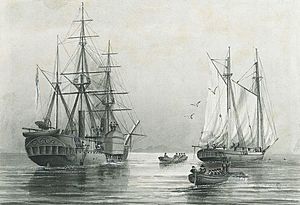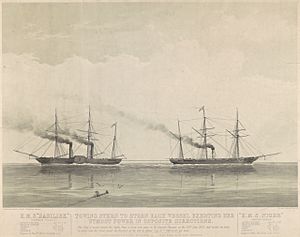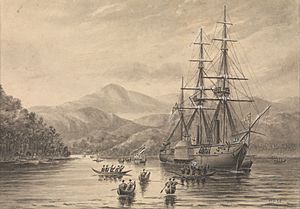HMS Basilisk (1848) facts for kids

Basilisk (left) and the merchant ship Queen Anne (right)
|
|
Quick facts for kids History |
|
|---|---|
| Name | HMS Basilisk |
| Ordered | 26 March 1846 |
| Builder | Woolwich Dockyard |
| Cost | £54,745 |
| Laid down | November 1846 |
| Launched | 22 August 1848 |
| Commissioned | July 1852 |
| Fate | Broken up at Chatham in 1882 |
| General characteristics | |
| Type | First-class paddle sloop |
| Displacement | 1,710 tons |
| Tons burthen |
|
| Length |
|
| Beam | 34 ft 0 in (10.4 m) |
| Depth of hold | 21 ft 6 in (6.6 m) |
| Installed power |
|
| Propulsion |
|
| Sail plan | Barque |
| Complement | 145 |
| Armament |
|
HMS Basilisk was a special type of warship called a paddle sloop. It was built for the Royal Navy in England. The ship was launched on August 22, 1848, at the Woolwich Dockyard.
Contents
Building the Basilisk
The Basilisk was designed by Oliver Lang. It was ordered on March 23, 1846, from Woolwich Dockyard. The ship started being built in November 1846. It was ready to be launched into the water on August 22, 1848.
How the Ship Moved
The Basilisk used large paddlewheels on its sides to move. These wheels were powered by a steam engine. The engine had two cylinders and was quite powerful for its time. It could produce about 1033 horsepower.
Ship's Weapons
The Basilisk carried several cannons. It had one large 68-pounder gun that could turn all the way around. It also had one 10-inch shell gun. For smaller targets, it carried four 32-pounder guns. These were all smoothbore guns, meaning the inside of the barrel was smooth.
Important Ship Tests
In 1849, the Basilisk took part in important tests in the English Channel. It was tested against another ship called HMS Niger. Both ships were designed very similarly. However, the Niger had a screw propeller, which is like a giant fan under the water. The Basilisk had paddlewheels.
These tests showed that screw propellers were much better than paddlewheels for moving warships. The Niger was faster and more efficient. This helped the Royal Navy decide to use screw propellers for future ships.
On April 7, 1853, the Basilisk accidentally ran aground near Southsea, England. This happened because a flag was raised that made it seem safe to enter Portsmouth Naval Base, but there wasn't enough water. A few crew members were hurt. The ship was later pulled free and taken to Portsmouth for repairs.
Serving in the Crimean War
After the tests, the Basilisk went to the Baltic Sea. It served there during the Crimean War from 1854 to 1855. Its job was to help block enemy ships.
On June 14, 1855, the Basilisk attacked and sank ten Russian ships carrying grain. On July 13, it sank some salt boats. It also helped in a battle on July 17 in the Gulf of Riga. There, it fought against Russian gunboats and shore batteries.
Journeys to Other Countries
After the Crimean War, the Basilisk traveled to different parts of the world. It served in North America and the West Indies. Later, it went to the China Station and Japan.
On July 27, 1868, the ship was pushed ashore during a storm in China. Repairs cost a lot of money. In March 1871, it began serving in the Australia Station. Captain John Moresby commanded the Basilisk when it visited the Ellice Islands in July 1872.
The Basilisk also helped to map the coastlines around New Guinea. Captain Moresby and his crew made many new discoveries during these surveys. The ship was also used to stop the illegal practice of "blackbirding." This was when people were tricked or forced into working far from home.
The Basilisk left the Australia Station in 1874 and sailed back to England.
The End of the Basilisk
The Basilisk was taken out of service and taken apart in Chatham in 1882.



